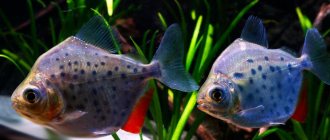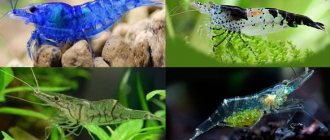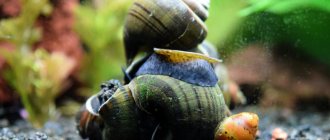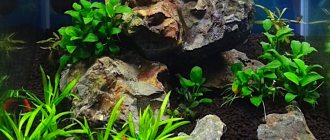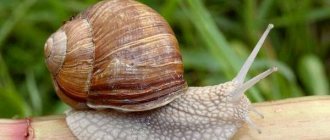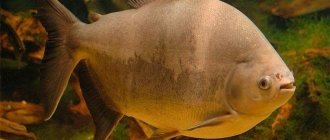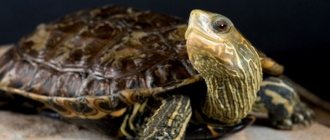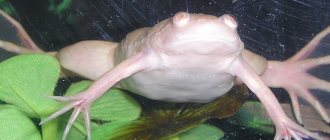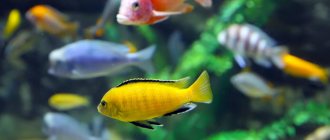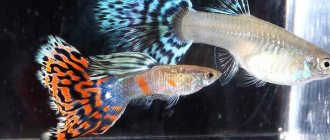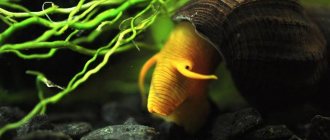Description
In nature, pygocentrus nattereri grows up to 35 cm, in an aquarium up to 25 cm, and lives in large lakes, rivers, small ponds and flooded forests. It lives in flocks of 20–30 individuals; in nature, this tactic simplifies hunting. A group of piranhas can tear their prey to pieces. They attack more often in case of danger. There are species whose average size does not exceed 15 cm.
Appearance
The body is long, laterally flattened. The jaw is convex, there are sharp large teeth. The tail is powerful. The body color is predominantly silver-gray with shimmering dots, and the belly is red. Juveniles are different from adults.
Difficult character
Piranha is dangerous to many other tankmates. Can severely bite an inattentive owner. When kept alone or in pairs in an aquarium, piranhas are timid and react to sudden movements and loud sounds. They feel more confident in a flock of 10 individuals. The group develops a hierarchy, with the dominant individual getting the best pieces of food. There are cases of cannibalism, when a weak and sick individual is eaten.
Lifespan
At home, piranhas live 10–15 years. A record number of 28 years was recorded for the red pacu.
Piranha hunting
All fish of this family are edible and tasty. The aborigines living on the banks of the rivers where they are found have a whole fishery for these predators. Their meat resembles perch; in the Amazon, piranha is considered a delicacy. But catching piranhas is not a safe activity.
The fisherman places the bait on a large hook, hooks it onto a metal wire and lowers the entire structure into the river. After a minute, you can pull out and shake the catch ashore. Then they lower it again, and you can catch until your hand gets tired. Packs of these hunters are simply enormous in size.
You just have to be careful not to get hurt or drop a drop of blood into the water. Otherwise, they may start jumping out on their own and clinging to your hand. Unlucky fishermen lost fingers while fishing like this. It would be more correct to call this fishing piranha hunting.
I would just like to warn fans of extreme sports. It is impossible for an ignorant person on a river to distinguish a predatory fish from a herbivorous one. Therefore, it is better to catch catfish and perch.
Kinds
The most popular species are the common piranha and the red-bellied piranha. The piranha family has 16 genera and almost 100 species.
Redfin mile
The color of myloplus rubripinnis is silver, the anal fin is bright red, and the tail is translucent. There are varieties with a reddish belly and red-gold spots on the body. In an aquarium it grows up to 15 cm, in nature - up to 25 cm.
Brown pacu
The average size of a pacu is 70 cm, the body is colored in dark, gray and brown tones. The teeth are square, reminiscent of human teeth. Schooling in this species is less pronounced. Suitable for single living.
Red pacu
The red pacu is a herbivorous species, also known as the red-bellied and red-breasted pacu, the two-toothed colossoma, and the vegetarian piranha. The average size in the aquarium is 60 cm. Peaceful and shy fish. It is possible to keep them with many species of comparable size or alone.
Flag
The silvery body is laterally compressed, with a greenish tint on the back. The gill covers have a red spot, the first rays of the fins are elongated and transparent. The tail is forked. The lower jaw is massive. Predatory view.
Slender
The body of the fish is elongated. The color of the scales is silver with a black border on the tail and red on the sides.
Natterera
Natterer's piranha is named after an Australian scientist, known as "saikanga", and the Latin name is Pygocentrus nattereri, a synonym is Serrasalmus nattereri. The body is disc-shaped, reaches 35 cm in length. The color is bright, bluish, the abdomen and fins are bright red, and there is a wide blue stripe on the dark tail.
Lunar Metinnis
These piranhas have a tall body and a light silver color, with a red spot on the gill covers. Herbivorous species. Grows up to 25 cm.
Metinnis silver
The piranha is known as the silver dollar because of its resemblance to a coin. Latin name metynnis argenteus ahl. The size of the silver metinnis is small - 10–15 cm. Males have a veil anal fin, females have a straight one.
Metinnis vulgaris
The abdomen of Metinnis is silvery-white with blue and greenish tints, the fins are transparent. The body is round, strongly flattened laterally. Grows up to 15 cm. Known as mirror fish.
Common Metynnis (Metynnis hypsauchen) Müller Troschel.
A small variety of piranha. It has a silver body color with a white belly and transparent fins. The back of Metinnison vulgaris can have a grayish-blue, brown or green tint. The scales have a blue, yellow or greenish tint. The end of the anal fin is red. The body of the fish is high and round, strongly flattened on the sides. There may be black transverse stripes and spots along the sides.
Genera and species of the piranha family in alphabetical order:
Show/Hide text
Acnodon (Eigenmann, 1903): Acnodon normani (Gosline, 1951), Acnodon oligacanthus (Müller & Troschel, 1844), Acnodon senai (Jégu & Santos, 1990).
Catoprion (Müller et Troschel, 1844): Catoprion mento (Cuvier, 1819), Colossoma (Eigenmann et Kennedy, 1903), Colossoma macropomum (Cuvier, 1816).
Metynnis (Cope, 1878): Metynnis altidorsalis (Ahl, 1923), Metynnis argenteus (Ahl, 1923), Metynnis cuiaba (Pavanelli, Ota & Petry, 2009), Metynnis fasciatus (Ahl, 1931), Metynnis guaporensis (Eigenmann, 1915) , Metynnis hypsauchen (Müller & Troschel, 1844), Metynnis lippincottianus (Cope, 1870), Metynnis longipinnis (Zarske & Géry, 2008), Metynnis luna (Cope, 1878), Metynnis maculatus (Kner, 1858), Metynnis mola (Eigenmann & Kennedy, 1903), Metynnis orinocensis (Steindachner, 1908), Metynnis otuquensis (Ahl, 1923), Metynnis polystictus (Zarske & Géry, 2008).
Piranha photo
Mylesinus (Cuvier et Valenciennes, 1849): Mylesinus paraschomburgkii (Jégu, Santos & Ferreira, 1989), Mylesinus paucisquamatus (Jégu & Santos, 1988), Mylesinus schomburgkii (Valenciennes, 1850).
Myleus (Müller et Troschel, 1844): Myleus altipinnis (Valenciennes, 1850), Myleus knerii (Steindachner, 1881), Myleus latus (Jardine, 1841), Myleus micans (Lütken, 1875), Myleus pacu (Jardine, 1841), Myleus setiger (Müller & Troschel, 1844).
Myloplus (Gill, 1896): Myloplus arnoldi (Ahl, 1936), Myloplus asterias (Müller & Troschel, 1844), Myloplus laevis (Eigenmann & McAtee, 1907), Myloplus lobatus (Valenciennes, 1850), Myloplus lucienae (Andrade, Ota, Bastos & Jégu, 2016), Myloplus planquettei (Jégu, Keith & Le Bail, 2003), Myloplus rhomboidalis (Cuvier, 1818), Myloplus rubripinnis (Müller & Troschel, 1844), Myloplus schomburgkii (Jardine, 1841), Myloplus ternetzi (Norman , 1929), Myloplus tiete (Eigenmann & Norris, 1900), Myloplus torquatus (Kner, 1858), Myloplus zorroi (Andrade, Jégu & Giarrizzo, 2016).
Piranha photo
Mylossoma (Eigenmann et Kennedy, 1903): Mylossoma acanthogaster (Valenciennes, 1850), Mylossoma aureum (Spix & Agassiz, 1829), Mylossoma duriventre (Cuvier, 1818).
Ossubtus (Jégu, 1992): Ossubtus xinguense (Jégu, 1992).
Piaractus (Eigenmann, 1903): Piaractus brachypomus (Cuvier, 1818), Piaractus mesopotamicus (Holmberg, 1887).
Pristobrycon (Eigenmann, 1915): Pristobrycon aureus (Spix & Agassiz, 1829), Pristobrycon calmoni (Steindachner, 1908), Pristobrycon careospinus (Fink & Machado-Allison, 1992), Pristobrycon maculipinnis (Fink & Machado-Allison, 1992), Pristobrycon striolatus (Steindachner, 1908).
Piranha teeth mouth photo
Pygocentrus (Müller et Troschel, 1844): Pygocentrus cariba (Humboldt, 1821), Pygocentrus nattereri (Kner, 1858), Pygocentrus palometa (Valenciennes, 1850), Pygocentrus piraya (Cuvier, 1819).
Pygopristis (JP Müller & Troschel, 1844): Pygopristis denticulata (Cuvier, 1819).
Piranha photo
Serrasalmus (Lacepède, 1803): Serrasalmus altispinis (Merckx, Jégu & Santos, 2000), Serrasalmus Altuvei (Ramírez, 1965), Serrasalmus auriventris (Burmeister, 1861), SERRASALMUS Branmus Bran DTII (Lütken, 1875), Serrasalmus Compressus (Jégu, Lege & Santos, 1991), Serrasalmus eigenmanni (Norman, 1929), Serrasalmus elongatus (Kner, 1858), Serrasalmus emarginatus (Jardine, 1841), Serrasalmus geryi (Jégu & Santos, 1988), Serrasalmus gibbus (Castelnau, 1855), Serrasalmus gouldingi ( Fink & Machado-Allison, 1992), Serrasalmus hastatus (Fink & Machado-Allison, 2001), Serrasalmus hollandi (Eigenmann, 1915), Serrasalmus humeralis (Valenciennes, 1850), Serrasalmus irritans (Peters, 1877), Serrasalmus maculatus (Kner, 1858), Serrasalmus manueli (Fernández-Yépez & Ramírez, 1967), Serrasalmus marginatus (Valenciennes, 1837), Serrasalmus medinai (Ramírez, 1965), Serrasalmus nalseni (Fernández-Yépez, 1969), Serrasalmus neveriensis (Machado-Allison, Fink , López Rojas & Rodenas, 1993), Serrasalmus nigricans (Spix & Agassiz, 1829), Serrasalmus nigricauda (Burmeister, 1861), Serrasalmus odyssei (Hubert & Renno, 2010), Serrasalmus rhombeus (Linnaeus, 1766), Serrasalmus sanchezi (Géry, 1966) 4 ), Serrasalmus scotopterus (Jardine, 1841), Serrasalmus serrulatus (Valenciennes, 1850), Serrasalmus spilopleura (Kner, 1858), Serrasalmus stagnatilis (Jardine, 1841), Serrasalmus undulatus (Jardine, 1841).
Tometes (Cuvier et Valenciennes, 1849): Tometes ancylorhynchus (Andrade, Jégu & Giarrizzo, 2016), Tometes camunani (Andrade, Giarrizzo & Jégu, 2013), Tometes kranponhah (Andrade, Jégu & Giarrizzo, 2016), Tometes lebaili (Jégu, Keith & Belmont-Jégu, 2002), Tometes makue (Jégu, Santos & Belmont-Jégu, 2002), Tometes trilobatus (Valenciennes, 1850).
Utiaritichthys (Miranda Ribeiro, 1937): Utiaritichthys esguiceroi (Pereira & Castro, 2014), Utiaritichthys longidorsalis (Jégu, Tito de Morais & Santos, 1992), Utiaritichthys sennaebragai (Miranda Ribeiro, 1937)
Content
Piranha is an expensive fish; most species require high-quality live food, expensive equipment and a huge aquarium. Not recommended for beginners.
Aquarium
Each individual accounts for at least 120 liters. Place a small group of 4 individuals in a 500-liter aquarium. A school of fish will require a gigantic aquarium with a volume of thousands of liters.
Water parameters
| Temperature | 22–27 degrees |
| Acidity | 6,5–7 |
| Rigidity | 4–15 dGh |
| Water movement | weak or moderate |
It is necessary to maintain a comfortable temperature in the aquarium and monitor the cleanliness of the water. The liquid should not be cold or too warm. The feeding method of predators implies rapid water pollution. Some aquarists change 30–50% of the liquid weekly, others change 10–15% of the total water volume.
Plants
Under natural conditions, the piranha biotope is full of dense vegetation. Fish in an aquarium can damage plants. Place greens that don't require a lot of light:
- Java moss;
- ferns;
- Anubias;
- blue.
- plants;
- caves;
- grottos;
- driftwood
- Filter. Large capacity will require multiple devices. Give preference to an external filter.
- Compressor. The device will provide oxygen saturation of the water.
- Thermometer and heater. Monitor the temperature in the aquarium and maintain it at a level that is comfortable for your pets. In hot weather, a cooler or ice containers placed in water will help cool the water.
Shelters
Provide plenty of hiding places to make timid predators feel comfortable. Leave room for free swimming. Piranhas love shelter in the form of:
Priming
Place sand or fine gravel at the bottom.
Siphon the soil at least once a week, thoroughly cleaning the entire bottom.
Equipment
Equip your aquarium:
Lighting
Choose moderate lighting that suits plants and fish. Too much light causes stress for piranhas. To prevent the appearance of algae, select light in the blue and red spectrum, excluding yellow. Do not allow sunlight to hit the walls of the aquarium. Place the tank at least 1.5 meters from the window. Make sure that the lamp does not overheat the liquid.
Breeding
They reproduce well in captivity. Female red-bellied piranhas are usually larger than males. Predators choose their own mates. They reach sexual maturity at about one year of age.
By this time, their body usually reaches a size of 10-15 cm.
The “couple in love” is transplanted into a separate spawning tank. It must have a volume of at least 150 liters. You need to change the water by ¼ every day. Carefully monitor the temperature of the water in the container; it should be 26-29° C.
Males make a hole in the ground from pebbles, and females lay eggs in it.
There are up to 1500 eggs. Both parents protect their offspring.
Incubation of eggs does not last long, only 2-3 days.
After 5 days, the young critters begin to feed on their own.
If one of the young animals is smaller than others in size, then they need to be resettled separately.
Large “kids” will eat a little brother or sister “without regret.”
What to feed
Feed the animals once a day. A portion of food should be eaten within a couple of minutes, then the piranha will not overeat, and the water will not be contaminated with uneaten food. Provide food commensurate with the jaws of the fish; the piranha ignores food that is too small. Piranhas differ greatly in the type of food they eat. However, occasionally predators need plant nutrition, just as vegetarians sometimes need variety in the form of live food.
Predatory
Feed carnivorous piranha species:
Once a week, give predators a fasting day. Make sure that all the inhabitants of the aquarium are well-fed, because in case of malnutrition, mutual oppression or eating of other species will begin. Serve mammalian meat as a supplement to the diet, do not abuse it.
Herbivores
Unlike carnivorous species, herbivores accept dry food. The basis of the diet are:
Feed with tubifex and bloodworms. Animal feed should not exceed 20% of the diet.
Feeding
The issue of nutrition is quite complex. They don't want to eat dry food. We have to feed him natural meat products. Beef, squid, shrimp, small frogs, and sea fish fillets are suitable.
Some experienced aquarists recommend giving a little beef heart.
This “delicacy” is to the taste of toothies.
If the owner can withstand the cruel spectacle, then you can add goldfish , guppies, and swordtails to the diet.
The number of feedings is 1 time per day.
Uneaten food residues must be removed using a soil cleaner.
During spawning, future parents need increased nutrition.
The fry are fed daphnia. As babies grow, bloodworms and tubifex are added to the diet.
Young animals are transferred to the “common table” at 4 months.
Compatibility
Keep large predatory piranhas in a species aquarium. Despite the aggressive nature, it is possible to live with large catfish such as plecostomus and pterygoplichthys. Small fish will become prey for piranhas. Mix herbivorous peaceful piranhas with comparable species, for example, representatives of the characin family, giant gouramis or shark barbs. Make sure that the water parameters are suitable for different fish.
Tips for an aquarist
All equipment should be purchased and tested in advance, and the aquarium should be started immediately before the piranhas are introduced.
During the first hours after moving in, you should not feed the fish or turn on the lighting or equipment - you need to give your pets time to get used to the new aquarium.
A metal net should be used to catch fish.
Cleaning the aquarium must be done carefully, without sudden movements.
Piranhas can jump out of the aquarium, so it is necessary to cover it with a lid. If the fish does jump onto the floor, you should not catch it with your hands - in a stressed state, it can bite strongly.
A lonely piranha in an aquarium can become depressed, refuse to eat and die. It is best to start a species aquarium with a flock of five to six piranhas of the same age and size.
Despite their aggressive behavior, piranhas are amazing and fascinating creatures that you can watch for hours. Thanks to their exoticism and unpretentiousness, many people fell in love with pets, and now an aquarium with piranhas is a fairly common occurrence. The main thing is not to forget to care for the fish and follow safety rules.
Would you dare to have piranhas in your aquarium? Why? Share your opinions in the comments.
Reproduction
Piranhas can be bred in an aquarium, but creating the necessary conditions is difficult. The volume of the spawning aquarium starts from 200 liters. During the spawning period, it is necessary to monitor the purity of the water and the stability of parameters. Feed the future parents a high protein animal feed to prepare for spawning.
Sex differences
Sexual maturity occurs at 1.5 years. It is difficult to determine the sex of the fish. Closer to spawning, the males acquire an intense color, and the female’s abdomen becomes rounded from the eggs.
Spawning
Piranhas take care of their young. The fish choose a place to lay eggs and carefully guard the eggs. Depending on the species and individual characteristics of the female, there are 500–15,000 eggs in the clutch. The incubation period lasts 2–15 days. At this time, the male piranha may attack the female, so remove the female.
Fry
Hatched fry grow unevenly, sort the young by size and place larger and smaller piranhas. Starter food: Artemia nauplii, later feed:
Purchase and how much it costs
When buying fish, make sure that the piranhas are healthy: active, not injured, without impaired coordination of movements. You can buy them via the Internet and from a breeder, in a specialized store (preferably), or from the owner for whom they did not suit for some reason.
When buying fish, make sure that the piranhas are healthy: active, not injured
Depending on the type and size, piranhas cost from 500 to 3000 rubles.
Diseases
Piranhas are hardy and rarely get sick. In poor conditions they are susceptible to:
Effective medications for most diseases can be purchased at a pet store. Before treating fish, read the instructions and determine the causes of the disease. Adjust the conditions: check the water for nitrates and other dangerous compounds, provide the piranhas with a balanced diet and make sure that the water parameters in the home aquarium are suitable for the fish.
Piranha habitat
Piranha habitat
Piranha habitat
Piranha habitat
Piranhas are a family of freshwater fish from the order Characinidae, living in the waters of South America (Argentina, Bolivia, Brazil, Venezuela, Colombia, Paraguay, Peru, Uruguay, Ecuador, etc.), in the rivers of the Amazon, Parana, Uruguay, Essequibo, and Orinoco basins. Piranhas feel equally good both in rivers and in channels and floodplain lakes.
Reviews
Owners of these interesting fish note that it is fascinating to observe the habits of predators. The intelligence and bewitching appearance of the fish are amazing. Some aquarists have encountered piranhas being aggressive towards neighbors of other species, especially in a small aquarium.
General characteristics
Piranhas gather in schools, which makes it easier to find food, and pose a real threat to living objects they encounter. After the attack, the victim is torn to pieces within a few minutes. Some species of piranhas are not predators. Approximately 60% of fish feed on food of plant origin.
The reputation of predatory inhabitants of water bodies is not always deserved. Fish attack only when they think they are in danger, can get caught in a trap, or when they feel hungry. At the same time, some countries (for example, Israel) prohibit the possession, trade, storage, and shelter of these fish. Such actions are considered illegal.
Photo
How to keep it in an aquarium
Pacu is a dangerous tropical species, but it is also a fairly popular domestic fish. Any inexperienced aquarist can keep them without any problems. It is necessary to purchase a tank of sufficient volume (about 200 liters) for them and install powerful filters to maintain high water quality. An aerator, a heater and lamps for lighting are required. For decoration, driftwood, stones and artificial seaweed are used so that the fish do not eat them. If you plan to keep several individuals, then you need to take care of the possibility of them turning around. Rapid growth is observed, although in captivity they do not reach the same size as in nature. On average, the length is 30-40 cm, and the weight is no more than 2 kg, although cases of 60-88 cm and 25 kg are known.
Characteristics
Aquarium piranhas have an oblong body. Its length reaches 30–33 cm. The dimensions of some phenotypes are 20 cm. The life cycle reaches 10 years. How long do these species live in natural conditions? The period reaches 15–20 years.
These aquarium fish have a distinctive feature by which even beginners can identify them. This phenotype is distinguished by its massive lower jaw and powerful tail.
The color of adult fish is silver-steel. All fins are colored red.
Interesting Facts
Some of them:
- In New Guinea in 1994, fishermen were attacked and killed. The cause was terrible wounds inflicted by an unknown creature, as a result of which people bled to death. The culprit was a huge killer Pacu, which the famous fisherman Jeremy Wade later managed to catch.
- For breeding as a commercial species, they were launched in the Sipik (1994) and Ramu (1997) rivers. Here they sometimes began to feed on small crocodiles and attack people.
- The largest individuals are found in Papua New Guinea.
- They became notorious as "egg eaters" after male swimmers lost their genitals in an attack (2001).
- The meat may taste like a hybrid striped bass, rainbow trout or tilapia, but will be better than catfish. The meat is soft and sweetish.
